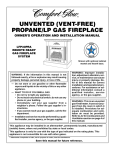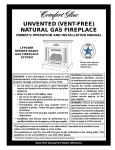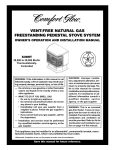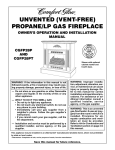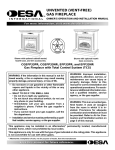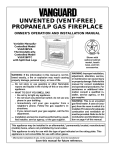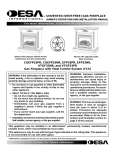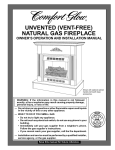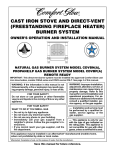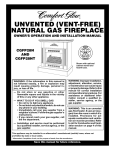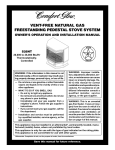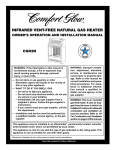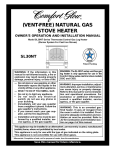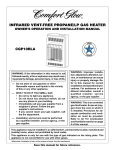Download Desa LFP33NRA User's Manual
Transcript
UNVENTED (VENT-FREE) NATURAL GAS FIREPLACE OWNER’S OPERATION AND INSTALLATION MANUAL LFP33NRA REMOTE READY GAS FIREPLACE SYSTEM Shown with optional cabinet mantel and hearth base. WARNING: If the information in this manual is not followed exactly, a fire or explosion may result causing property damage, personal injury, or loss of life. — Do not store or use gasoline or other flammable vapors and liquids in the vicinity of this or any other appliance. — WHAT TO DO IF YOU SMELL GAS • Do not try to light any appliance. • Do not touch any electrical switch; do not use any phone in your building. • Immediately call your gas supplier from a neighbor’s phone. Follow the gas supplier’s instructions. • If you cannot reach your gas supplier, call the fire department. — Installation and service must be performed by a qualified installer, service agency, or the gas supplier. WARNING: Improper installation, adjustment, alteration, service, or maintenance can cause injury or property damage. Refer to this manual for correct installation and operational procedures. For assistance or additional information consult a qualified installer, service agency, or the gas supplier. WARNING: This is an unvented gas-fired heater. It uses air (oxygen) from the room in which it is installed. Provisions for adequate combustion and ventilation air must be provided. Refer to Air for Combustion and Ventilation section on page 4 of this manual. This appliance may be installed in an aftermarket*, permanently located, manufactured (mobile) home, where not prohibited by state or local codes. This appliance is only for use with the type of gas indicated on the rating plate. This appliance is not convertible for use with other gases. * Aftermarket: Completion of sale, not for purpose of resale, from the manufacturer Save this manual for future reference. LFP33NRA UNVENTED NATURAL GAS FIREPLACE SAFETY INFORMATION Due to high temperatures, the appliance should be located out of traffic and away from furniture and draperies. WARNINGS Do not place clothing or other flammable material on or near the appliance. Never place any objects on the heater. IMPORTANT: Read this owner’s manual carefully and completely before trying to assemble, operate, or service this fireplace. Improper use of this fireplace can cause serious injury or death from burns, fire, explosion, electrical shock, and carbon monoxide poisoning. Fireplace front and screen becomes very hot when running fireplace. Keep children and adults away from hot surfaces to avoid burns or clothing ignition. Fireplace will remain hot for a time after shutdown. Allow surfaces to cool before touching. DANGER: Carbon monoxide poisoning may lead to death! Carbon Monoxide Poisoning: Early signs of carbon monoxide poisoning resemble the flu, with headaches, dizziness, or nausea. If you have these signs, the fireplace may not be working properly. Get fresh air at once! Have fireplace serviced. Some people are more affected by carbon monoxide than others. These include pregnant women, people with heart or lung disease or anemia, those under the influence of alcohol, and those at high altitudes. Carefully supervise young children when they are in the room with heater. When using the handheld remote accessory, keep selector switch in the OFF position to prevent children from turning on burners with remote. odor-making agent is added to the gas. The odor helps you detect a gas leak. However, the odor added to the gas can fade. Gas may be present even though no odor exists. Make certain you read and understand all warnings. Keep this manual for reference. It is your guide to safe and proper operation of this fireplace. WARNING: Do not allow fans to blow directly into the fireplace. Avoid any drafts that alter burner flame patterns. Ceiling fans can create drafts that alter burner flame patterns. Altered burner patterns can cause sooting. WARNING: Do not use a blower insert, heat exchanger insert, or other accessory not approved for use with this heater. 5. 6. 7. 8. 9. You must operate this fireplace with the fireplace screen and hood in place. Make sure fireplace screen and hood are in place before running fireplace. Natural Gas: Natural gas is odorless. An WARNING: Any change to this heater or its controls can be dangerous. 4. Keep the appliance area clear and free from combustible materials, gasoline, and other flammable vapors and liquids. 1. 2. 3. This appliance is only for use with the type of gas indicated on the rating plate. This appliance is not convertible for use with other gases. If you smell gas • shut off gas supply • do not try to light any appliance • do not touch any electrical switch; do not use any phone in your building • immediately call your gas supplier from a neighbor’s phone. Follow the gas supplier’s instructions • if you cannot reach your gas supplier, call the fire department This fireplace shall not be installed in a bedroom or bathroom. 2 10. 11. 12. 13. 14. 15. Do not use this fireplace as a woodburning fireplace. Use only the logs provided with the fireplace. Do not add extra logs or ornaments such as pine cones, vermiculite, or rock wool. Using these added items can cause sooting. Do not add lava rock around base. Rock and debris could fall into the control area of fireplace. This fireplace is designed to be smokeless. If logs ever appear to smoke, turn off fireplace and call a qualified service person. Note: During initial operation, slight smoking could occur due to log curing and fireplace burning manufacturing residues. To prevent the creation of soot, follow the instructions in Cleaning and Maintenance, page 18. Before using furniture polish, wax, carpet cleaner, or similar products, turn heater off. If heated, the vapors from these products may create a white powder residue within burner box or on adjacent walls or furniture. This fireplace needs fresh air ventilation to run properly. This fireplace has an Oxygen Depletion Sensing (ODS) safety shutoff system. The ODS shuts down the fireplace if not enough fresh air is available. See Air for Combustion and Ventilation, pages 4 through 6. If fireplace keeps shutting off, see Troubleshooting, pages 19 through 21. Do not run fireplace • where flammable liquids or vapors are used or stored • under dusty conditions Do not use this fireplace to cook food or burn paper or other objects. Do not use fireplace if any part has been exposed to or under water. Immediately call a qualified service technician to inspect the fireplace and to replace any part of the control system and any gas control which has been under water. Do not operate fireplace if any log is broken. Do not operate fireplace if a log is chipped (dime-sized or larger). Turn fireplace off and let cool before servicing. Only a qualified service person should service and repair fireplace. Operating fireplace above elevations of 4,500 feet could cause pilot outage. 107063 OWNER’S MANUAL PRODUCT IDENTIFICATION LOCAL CODES Log Set Install and use fireplace with care. Follow all local codes. In the absence of local codes, use the latest edition of The National Fuel Gas Code, ANS Z223.1, also known as NFPA 54*. *Available from: American National Standards Institute, Inc. 1430 Broadway New York, NY 10018 H I National Fire Protection Association, Inc. Batterymarch Park Quincy, MA 02269 L UNPACKING O P ILOT N O FF O Control Knobs 1. Piezo Ignitor Remote Selector Switch (Optional) Optional Remote Control Figure 1 - Log Base Assembly 2. Top Outer Casing 3. Top Louvered Hood 4. Firebox Support With utility knife, cut the carton all the way around above the staples on the bottom tray. Lift the carton off the heater. Remove packing. Note: The hood is located in the packing on the right hand side of the heater front. Lift the heater off the bottom tray. Locate two screws above top corners of the fireplace screen. Remove and discard these screws. Lift fireplace screen up and pull out to remove. Remove protective packaging applied to logs, log base assembly, and fireplace. Check all items for any shipping damage. If damaged, promptly inform dealer where you bought fireplace. REMOTE CONTROL ACCESSORIES The remote controls that can be purchased separately for this log heater are hand held remotes. See Accessories, pages 24 and 25. Rear Access Door Screen Assembly Figure 2 - Fireplace 107063 Bottom Louver Assembly 3 LFP33NRA UNVENTED NATURAL GAS FIREPLACE PRODUCT FEATURES OPERATION This vent-free fireplace is clean burning. It requires no outside venting. There is no heat loss out a vent or up a chimney. Heat is generated by both realistic flames and glowing embers. When used without the blower, the fireplace requires no electricity making it ideal for emergency backup heat. SAFETY DEVICE This fireplace has a pilot with an Oxygen Depletion Sensing (ODS) safety shutoff system. The ODS/pilot is a required feature for vent-free room heaters. The ODS system shuts off the fireplace if there is not enough fresh air. PIEZO IGNITION SYSTEM This fireplace has a piezo ignitor. This system requires no matches, batteries, or other sources to light fireplace. BLOWER ASSEMBLY (GA3750 and GA3650T Series) This fireplace accepts an optional blower assembly. The GA3750 blower has a manual variable control. The GA3650T blower operates thermostatically. The blower circulates heated air from the fireplace into the room. Use of blower is optional. See Accessories, pages 24 and 25. AIR FOR COMBUSTION AND VENTILATION WARNING: This heater shall not be installed in a confined space or unusually tight construction unless provisions are provided for adequate combustion and ventilation air. Read the following instructions to insure proper fresh air for this and other fuel-burning appliances in your home. Today’s homes are built more energy efficient than ever. New materials, increased insulation, and new construction methods help reduce heat loss in homes. Home owners weather strip and caulk around windows and doors to keep the cold air out and the warm air in. During heating months, home owners want their homes as airtight as possible. While it is good to make your home energy efficient, your home needs to breathe. Fresh air must enter your home. All fuel-burning appliances need fresh air for proper combustion and ventilation. Exhaust fans, fireplaces, clothes dryers, and fuel burning appliances draw air from the house to operate. You must provide adequate fresh air for these appliances. This will insure proper venting of vented fuelburning appliances. PROVIDING ADEQUATE VENTILATION The following are excerpts from National Fuel Gas Code, NFPA 54/ANS Z223.1, Section 5.3, Air for Combustion and Ventilation. All spaces in homes fall into one of the three following ventilation classifications: 1. Unusually Tight Construction 2. Unconfined Space 3. Confined Space The information on pages 4 through 6 will help you classify your space and provide adequate ventilation. buildings of unusually tight construction, you must provide additional fresh air. Unusually tight construction is defined as construction where: a. walls and ceilings exposed to the outside atmosphere have a continuous water vapor retarder with a rating of one perm (6 x 10-11 kg per pa-sec-m2) or less with openings gasketed or sealed and b. weather stripping has been added on openable windows and doors and c. caulking or sealants are applied to areas such as joints around window and door frames, between sole plates and floors, between wall-ceiling joints, between wall panels, at penetrations for plumbing, electrical, and gas lines, and at other openings. If your home meets all of the three criteria above, you must provide additional fresh air. See Ventilation Air From Outdoors, page 6. If your home does not meet all of the three criteria above, proceed to Determining Fresh-Air Flow for Fireplace Location on page 5. Confined Space and Unconfined Space The National Fuel Gas Code, ANS Z223.1 defines a confined space as a space whose volume is less than 50 cubic feet per 1,000 Btu per hour (4.8 m3 per kw) of the aggregate input rating of all appliances installed in that space and an unconfined space as a space whose volume is not less than 50 cubic feet per 1,000 Btu per hour (4.8 m3 per kw) of the aggregate input rating of all appliances installed in that space. Rooms communicating directly with the space in which the appliances are installed*, through openings not furnished with doors, are considered a part of the unconfined space. Unusually Tight Construction This heater shall not be installed in a confined space of unusually tight construction unless provisions are provided for adequate combustion and ventilation air. The air that leaks around doors and windows may provide enough fresh air for combustion and ventilation. However, in * Adjoining rooms are communicating only if there are doorless passageways or ventilation grills between them. 4 107063 OWNER’S MANUAL AIR FOR COMBUSTION AND VENTILATION Continued DETERMINING FRESH-AIR FLOW FOR FIREPLACE LOCATION Determining if You Have a Confined or Unconfined Space Use this work sheet to determine if you have a confined or unconfined space. Space: Includes the room in which you will install fireplace plus any adjoining rooms with doorless passageways or ventilation grills between the rooms. 1. Determine the volume of the space (length x width x height). Length x Width x Height = _________________ cu. ft. (volume of space) Example: Space size 22 ft. (length) x 18 ft. (width) x 8 ft. (ceiling height) = 3168 cu. ft. (volume of space) If additional ventilation to adjoining room is supplied with grills or openings, add the volume of these rooms to the total volume of the space. 2. Divide the space volume by 50 cubic feet to determine the maximum Btu/Hr the space can support. _________________ (volume of space) ÷ 50 cu. ft. = (Maximum Btu/Hr the space can support) Example: 3168 cu. ft. (volume of space) ÷ 50 cu. ft. = 63.3 or 63,300 (maximum Btu/Hr the space can support) 3. Add the Btu/Hr of all fuel burning appliances in the space. Vent-free fireplace ___________________ Btu/Hr Gas water heater* ___________________ Btu/Hr Gas furnace ___________________ Btu/Hr Example: 40,000 Btu/Hr Vented gas heater ___________________ Btu/Hr Gas water heater Gas fireplace logs ___________________ Btu/Hr Vent-free fireplace + 33,000 Btu/Hr = 73,000 Btu/Hr Other gas appliances* + ___________________ Btu/Hr Total Total = ___________________ Btu/Hr * Do not include direct-vent gas appliances. Direct-vent draws combustion air from the outdoors and vents to the outdoors. 4. Compare the maximum Btu/Hr the space can support with the actual amount of Btu/Hr used. _________________ Btu/Hr (maximum the space can support) _________________ Btu/Hr (actual amount of Btu/Hr used) Example: 63,300 Btu/Hr (maximum the space can support) 73,000 Btu/Hr (actual amount of Btu/Hr used) The space in the above example is a confined space because the actual Btu/Hr used is more than the maximum Btu/Hr the space can support. You must provide additional fresh air. Your options are as follows: A. Rework work sheet, adding the space of an adjoining room. If the extra space provides an unconfined space, remove door to adjoining room or add ventilation grills between rooms. See Ventilation Air from Inside Building, page 6. B. Vent room directly to the outdoors. See Ventilation Air from Outdoors, page 6. C. Install a lower Btu/Hr fireplace, if lower Btu/Hr size makes room unconfined. If the actual Btu/Hr used is less than the maximum Btu/Hr the space can support, the space is an unconfined space. You will need no additional fresh air ventilation. WARNING: If the area in which the heater may be operated is smaller than that defined as an unconfined space or if the building is of unusually tight construction, provide adequate combustion and ventilation air by one of the methods described in the National Fuel Gas Code, ANS Z223.1, Section 5.3 or applicable local codes. Continued 107063 5 LFP33NRA UNVENTED NATURAL GAS FIREPLACE AIR FOR COMBUSTION AND VENTILATION Continued VENTILATION AIR Ventilation Air From Inside Building 12" Ventilation Grills Into Adjoining Room, Option 1 This fresh air would come from an adjoining unconfined space. When ventilating to an adjoining unconfined space, you must provide two permanent openings: one within 12" of the ceiling and one within 12" of the floor on the wall connecting the two spaces (see options 1 and 2, Figure 3). You can also remove door into adjoining room (see option 3, Figure 3). Follow the National Fuel Gas Code, NFPA 54/ANS Z223.1, Section 5.3, Air for Combustion and Ventilation for required size of ventilation grills or ducts. Ventilation Grills Into Adjoining Room, Option 2 Or Remove Door into Adjoining Room, Option 3 12" Figure 3 - Ventilation Air from Inside Building WARNING: Rework worksheet, adding the space of the adjoining unconfined space. The combined spaces must have enough fresh air to supply all appliances in both spaces. Outlet Air Ventilated Attic Ventilation Air From Outdoors Provide extra fresh air by using ventilation grills or ducts. You must provide two permanent openings: one within 12" of the ceiling and one within 12" of the floor. Connect these items directly to the outdoors or spaces open to the outdoors. These spaces include attics and crawl spaces. Follow the National Fuel Gas Code, NFPA 54/ANS Z223.1, Section 5.3, Air for Combustion and Ventilation for required size of ventilation grills or ducts. IMPORTANT: Do not provide openings for inlet or outlet air into attic if attic has a thermostat-controlled power vent. Heated air entering the attic will activate the power vent. Outlet Air To Attic To Crawl Space Inlet Air Inlet Air Ventilated Crawl Space Figure 4 - Ventilation Air from Outdoors 6 107063 OWNER’S MANUAL INSTALLATION NOTICE: This heater is intended for use as supplemental heat. Use this heater along with your primary heating system. Do not install this heater as your primary heat source. If you have a central heating system, you may run system’s circulating blower while using heater. This will help circulate the heat throughout the house. In the event of a power outage, you can use this heater as your primary heat source. WARNING: A qualified service person must install fireplace. Follow all local codes. Use the dimensions shown for rough openings to create the easiest installation (see Built-In Fireplace Installation, page 9). IMPORTANT: Vent-free heaters add moisture to the air. Although this is beneficial, installing fireplace in rooms without enough ventilation air may cause mildew to form from too much moisture. See Air for Combustion and Ventilation, pages 4 through 6. IMPORTANT: Make sure the fireplace is level. If fireplace is not level, log set will not work properly. 6. 7. 8. While firmly holding edges of brass trim together, tighten both set screws on the adjusting plate with slotted screwdriver. Repeat steps 1 through 6 for other side. Tighten trim hanging screws (#10 x 6.25 shoulder) into holes in cabinets. Place the assembled trim onto fireplace cabinet. Align hanging notches on trim with hanging screws on side of fireplace (see Figure 6). Push trim firmly into place, sliding hanging notches over hanging screws. CHECK GAS TYPE Use only natural gas. If your gas supply is not natural gas, do not install fireplace. Call dealer where you bought fireplace for proper type fireplace. Set Screws Top Brass Trim Side Brass Trim Adjusting Plate ELECTRICAL HOOKUP (Optional Blower Accessory) WARNING: Never install the fireplace • in a bedroom or bathroom • in a recreational vehicle • where curtains, furniture, clothing, or other flammable objects are less than 42 inches from the front, top, or sides of the fireplace • in high traffic areas • in windy or drafty areas CAUTION: This fireplace creates warm air currents. These currents move heat to wall surfaces next to fireplace. Installing fireplace next to vinyl or cloth wall coverings or operating fireplace where impurities (such as tobacco smoke, aromatic candles, cleaning fluids, oil or kerosene lamps, etc.) in the air exist, may discolor walls. Note: Your Comfort Glow fireplace is designed to be used in zero clearance installations. Wall or framing material can be placed directly against any exterior surface on the rear, sides, or top of your fireplace, except where standoff spacers are integrally attached. If standoff spacers are attached to your fireplace, these spacers can be placed directly against wall or framing materials. This fireplace accepts a blower assembly with an electrical cord. The electrical cord is five feet in length. You must locate fireplace within reach of a 120 volt grounded electrical outlet. If not, you must install an electrical outlet within reach of fireplace power cord. Shim Slot Figure 5 - Assembling Brass Trim ASSEMBLING AND ATTACHING OPTIONAL BRASS TRIM (Included with Mantel Accessory) Trim Hanging Screws Hanging Notches on Trim IMPORTANT: If you are recessing the firebox in a wall, do not attach brass trim at this time. See page 9. Note: The instructions below show assembling and attaching brass trim to fireplace. 1. Remove packaging from three pieces of brass trim. 2. Locate four brass screws, two adjusting plates with set screws, and two shims in the hardware packet. 3. Align shim under adjusting plate as shown in Figure 5. 4. Slide one end of adjusting plate/shim in slot on mitered edge of top brass trim (see Figure 5). 5. Slide other end of adjusting plate/shim in slot on mitered edge of side brass trim (see Figure 5). Slot Mitered Edge Assembled Brass Trim Figure 6 - Attaching Brass Trim to Fireplace Continued 107063 7 LFP33NRA UNVENTED NATURAL GAS FIREPLACE CONVENTIONAL FIREPLACE INSTALLATION INSTALLATION Continued Conventional installation of this fireplace involves installing fireplace along with the corner, face, or cabinet mantel with hearth base accessories against a wall in your home. Follow the instructions below to install the fireplace in this manner. INSTALLATION CLEARANCES WARNING: Maintain the minimum clearances. If you can, provide greater clearances from floor, ceiling, and adjoining wall. Carefully follow the instructions below. This will ensure safe installation. Minimum Clearances For Side Combustible Material, Side Wall, and Ceiling A. Clearances from the side of the fireplace cabinet to any combustible material and wall should follow diagram in Figure 7. Example: The face of a mantel, bookshelf, etc. is made of combustible material and protrudes 3 1/2" from the wall. This combustible material must be 4" from the side of the fireplace cabinet (see Figure 7). B. Clearances from the top of the fireplace opening to the ceiling should not be less than 42 inches. 121/4 Example 8 3/ 4 7 51/4 31/2 13/4 INCHES 101/2 7/8 7/16 FIREBOX .5 1 2 4 6 8 10 12 14 16 * INCHES *Minimum 16 inches from Side Wall Figure 7 - Minimum Clearance for Combustible to Wall Note: The instructions below show installation using the cabinet mantel and hearth base accessories (see Accessories, pages 24 and 25). The hearth base accessory shown is optional for this installation. You can install fireplace and cabinet mantel directly on the floor. The corner mantel accessory cannot be installed with the hearth bases. You must install corner mantel directly on the floor. 1. Assemble cabinet mantel, hearth base, and trim accessories. Assembly instructions are included with each accessory. 2. When installing blower, install a properly grounded, 120 volt three-prong electrical outlet at fireplace location if an outlet is not there. If possible, locate outlet so cabinet mantel will cover it when installed (see Figure 8). 3. Install gas piping to fireplace location. This installation includes an approved flexible gas line (if allowed by local codes) after the equipment shutoff valve. The flexible gas line must be the last item installed on the gas piping. See Installing Gas Piping to Fireplace Location, page 10. 4. Place hearth base accessory against wall at installation location. Cut an access hole in hearth top to run flexible gas line to fireplace (see Figure 8). Make sure to locate access hole so cabinet mantel will cover it when installed. Note: You can secure base to floor using wood screws. Countersink screw heads and putty over. 5. Route flexible gas line through access hole in hearth base. 6. Center cabinet mantel on hearth base (see Figure 9). Make sure mantel is flush against wall. 7. Break off nailing flanges (see Figure 10, page 9) with hammer or pliers. 8 8. Place cardboard or other protective material on top of hearth base. Carefully set fireplace on protective material, with back of fireplace inside mantel opening. 9. Attach flexible gas line to fireplace gas regulator. See Connecting Fireplace to Gas Supply, page 11. 10. If blower is installed, route blower electrical cord through access holes in either side of fireplace. Note: Bushing may be moved if necessary. Plug electrical cord into electrical outlet. Hearth Base Flexible Gas Line Electrical Outlet Gas Line Access Hole Figure 8 - Placing Hearth Base Accessory Against Wall Cabinet Mantel Figure 9 - Installing Cabinet Mantel 107063 OWNER’S MANUAL BUILT-IN FIREPLACE INSTALLATION INSTALLATION Continued 11. Carefully insert fireplace into cabinet mantel. Be careful not to scratch or damage hearth base, cabinet mantel, or any laminate trim on hearth base. Remove protective material from top of hearth base and from front of fireplace (if any). Note: You can secure fireplace to hearth or floor. Open lower louver. Locate screw holes in bottom of base. Tighten wood screws through these holes and into hearth or floor. 12. Check all gas connections for leaks. See Checking Gas Connections, page 12. Built-in installation of this fireplace involves installing fireplace into a framed-in enclosure. This makes the front of fireplace flush with wall. If installing a mantel above the fireplace, you must follow the clearances shown in Figure 15, page 10 . Follow the instructions below to install the fireplace in this manner. Height Framing 32 3/8" 33" 5 Front Width 34 /16" Depth 1. 2. Nailing Flanges Figure 10 - Location of Nailing Flanges 3. 4. 5. Figure 11 - Inserting Fireplace Into Cabinet Mantel Actual 6. 7. 8. 16 11/16" 9. Check all gas connections for leaks. See Checking Gas Connections, page 12. 10. Install brass trim after final finishing and/or painting of wall (see Figure 6, page 7). 17 3/4" 33" 35 1/2" 17 3/4" Frame in rough opening. Use dimensions shown in Figure 12 for the rough opening. If installing in a corner, use dimensions shown in Figure 13 for the rough opening. The height is 33" which is the same as the wall opening above. If using blower, install and properly ground GA3555, three-prong 120 volt electrical outlet, in fireplace. Follow instructions included in kit (see Accessories, pages 24 and 25). Install gas piping to fireplace location. This installation includes an approved flexible gas line (if allowed by local codes) after the equipment shutoff valve. The flexible gas line must be the last item installed on the gas piping. See Installing Gas Piping to Fireplace Location, page 10. Carefully set fireplace in front of rough opening with back of fireplace inside wall opening. Attach flexible gas line to gas supply. See Connecting Fireplace to Gas Supply, page 11. Plug electrical cord into electrical outlet installed in step 2. Carefully insert fireplace into rough opening. Attach fireplace to wall studs using nails or wood screws through holes in nailing flange (see Figure 14). 35 1/2" Figure 12 - Rough Opening for Installing in Wall 39 3/8" 27 7/8" 35 1/2" 55 5/8" Figure 13 - Rough Opening for Installing in Corner Nails or Wood Screws Nailing Flanges Figure 14 - Attaching Fireplace to Wall Studs Continued 107063 9 LFP33NRA UNVENTED NATURAL GAS FIREPLACE INSTALLATION Continued Mantel Clearances for Built-In Installation If placing mantel above built-in fireplace, you must meet minimum clearance between mantel shelf and top of fireplace opening. NOTICE: If your installation does not meet the minimum clearances shown, you must do one of the following: • raise the mantel to an acceptable height • remove the mantel Framing Material Firebox Before installing fireplace, make sure you have the items listed below. • piping (check local codes) • sealant (resistant to propane/LP gas) • equipment shutoff valve * • test gauge connection * • sediment trap • tee joint • pipe wrench • approved flexible gas line with gas connector (if allowed by local codes) (not provided) * A CSA design-certified equipment shutoff valve with 1/8" NPT tap is an acceptable alternative to test gauge connection. Purchase the optional CSA design-certified equipment shutoff valve from your dealer. See Accessories, pages 24 and 25. Mantel Shelf 10" 8" 6" 2 1/2" Wire-mesh Screen WARNING: A qualified service person must connect fireplace to gas supply. Follow all local codes. Installation Items Needed NOTICE: Surface temperatures of adjacent walls and mantels become hot during operation. Walls and mantels above the firebox may become hot to the touch. If installed properly, these temperatures meet the requirement of the national product standard. Follow all minimum clearances shown in this manual. Wall board or facing material (above firebox) may be of combustible material, including decorative mantel ornaments or other similar projections off of the facing material. INSTALLING GAS PIPING TO FIREPLACE LOCATION Noncombustible Material May Project Off this Surface above the Firebox Hood Supplied Firebox Hood Must Be Used at All Times WARNING: Never connect fireplace to private (non-utility) gas wells. This gas is commonly known as wellhead gas. 13" 16" 19" 21" Note: All vertical measurements are from top of fireplace hood opening to bottom of mantel shelf. These minimum clearances replace any other recommended clearances supplied with your ANS Z21.11.2 approved gas logs. CAUTION: Use only new, black iron or steel pipe. Internally-tinned copper tubing may be used in certain areas. Check your local codes. Use pipe of 1/2" diameter or greater to allow proper gas volume to fireplace. If pipe is too small, undue loss of pressure will occur. Figure 15 - Minimum Mantel Clearances for Built-In Installation 10 107063 OWNER’S MANUAL INSTALLATION Continued CONNECTING FIREPLACE TO GAS SUPPLY Installation must include an equipment shutoff valve, union, and plugged 1/8" NPT tap. Locate NPT tap within reach for test gauge hook up. NPT tap must be upstream from fireplace (see Figure 16). IMPORTANT: Install equipment shutoff valve in an accessible location. The equipment shutoff valve is for turning on or shutting off the gas to the appliance. Check your building codes for any special requirements for locating equipment shutoff valve to fireplaces. Apply pipe joint sealant lightly to male threads. This will prevent excess sealant from going into pipe. Excess sealant in pipe could result in clogged fireplace valves. CAUTION: Use pipe joint sealant that is resistant to liquid petroleum (LP) gas. and contaminants. This keeps them from going into fireplace gas controls. If sediment trap is not installed or is installed wrong, fireplace may not run properly. 3. Installation Items Needed • 5/16" hex socket wrench or nut-driver • Phillips screwdriver • sealant (resistant to propane/LP gas, not provided) 1. Remove fireplace screen. Remove two screws that hold fireplace screen in place for shipping. These screws are located near top of screen. Discard screws. Lift fireplace screen up and pull out to remove. 2. Remove screws that attach log base assembly to fireplace (see Figure 17). Carefully lift up log base assembly and remove from fireplace (see Figure 17). CAUTION: Do not pick up log base assembly by burners. This could damage burners. Only handle base by grates. We recommend that you install a sediment trap in supply line as shown in Figure 16. Locate sediment trap where it is within reach for cleaning. Install in piping system between fuel supply and heater. Locate sediment trap where trapped matter is not likely to freeze. A sediment trap traps moisture Route gas line (provided by installer) from equipment shutoff valve to fireplace. Route flexible gas supply line through one of the access holes. NOTICE: Most building codes do not permit concealed gas connections. A flexible gas line is provided to allow accessibility from the fireplace (see Figure 18). The flexible gas supply line connection to the equipment shutoff valve should be accessible. 4. 5. 6. Attach the flexible gas line to gas supply (see Figure 18). Check tightness of flexible gas line attached to gas regulator of fireplace (see Figure 18). Check all gas connections for leaks. See Checking Gas Connections, page 12. Replace log base assembly back into fireplace. Feed flexible gas line into fireplace base area while replacing log base assembly. Make sure the entire flexible gas line is in fireplace base area. Reattach log base assembly to fireplace with screws removed in step 2. To Fireplace Gas Regulator ➞ CSA DesignCertified Equipment Shutoff Valve With 1/8" NPT Tap* Equipment Shutoff Valve Provided by Installer ➞ To Gas Meter H I Figure 18 - Attaching Gas Lines Together O O FF O N L Flexible Gas Line from Fireplace Gas Regulator P ILOT 3" Minimum Pipe Cap Nipple Tee Joint From Gas Meter (5" W.C. to 10.5" W.C. Pressure) Figure 17 - Removing Log Base Assembly From Fireplace Sediment Trap Figure 16 - Gas Connection * Purchase the optional CSA design-certified equipment shutoff valve from your dealer. See Accessories, pages 24 and 25 107063 Continued 11 LFP33NRA UNVENTED NATURAL GAS FIREPLACE INSTALLATION Continued CHECKING GAS CONNECTIONS WARNING: Test all gas piping and connections for leaks after installing or servicing. Correct all leaks at once. WARNING: Never use an open flame to check for a leak. Apply a mixture of liquid soap and water to all joints. Bubbles forming show a leak. Correct all leaks at once. Pressure Testing Gas Supply Piping System Test Pressures Equal To or Less Than 1/2 PSIG (3.5 kPa) Pressure Testing Fireplace Gas Connections 1. 1. 2. 3. 4. Close equipment shutoff valve (see Figure 19). Pressurize supply piping system by either using compressed air or opening main gas valve located on or near gas meter. Check all joints from gas meter to equipment shutoff valve (see Figure 20). Apply mixture of liquid soap and water to gas joints. Bubbles forming show a leak. Correct all leaks at once. Open 2. 3. 4. 5. 6. Disconnect appliance with its appliance main gas valve (control valve) and equipment shutoff valve from gas supply piping system. Pressures in excess of 1/2 psig will damage fireplace gas regulator. Cap off open end of gas pipe where equipment shutoff valve was connected. Pressurize supply piping system by either using compressed air or opening main gas valve located on or near gas meter. Check all joints of gas supply piping system. Apply mixture of liquid soap and water to gas joints. Bubbles forming show a leak. Correct all leaks at once. Reconnect fireplace and equipment shutoff valve to gas supply. Check reconnected fittings for leaks. 3. 4. 5. 6. ON POSITION Equipment Shutoff Valve 7. Test Pressures In Excess Of 1/2 PSIG (3.5 kPa) 1. 2. Open equipment shutoff valve (see Figure 19). Open main gas valve located on or near gas meter. Make sure control knob of fireplace is in the OFF position. Check all joints from equipment shutoff valve to thermostat gas valve (see Figure 20). Apply mixture of liquid soap and water to gas joints. Bubbles forming show a leak. Correct all leaks at once. Light fireplace (see Operating Fireplace, pages 16 and 17). Check all other internal joints for leaks. Turn off fireplace (see To Turn Off Gas to Appliance, page 17). OFF POSITION Closed Figure 19 - Equipment Shutoff Valve Equipment Shutoff Valve Gas Meter Manual Gas Valve Figure 20 - Checking Gas Joints 12 107063 OWNER’S MANUAL INSTALLATION Crossover Log (#4) "U"-shaped Cutout in Base H I Peg L O N O FF O H I P WARNING: Failure to position the parts in accordance with these diagrams or failure to use only parts specifically approved with this heater may result in property damage or personal injury. Middle Log (#1) ILOT Continued INSTALLING LOGS L O O N FF O ILOT Back Log (#2) INSTALLING SCREEN WARNING: You must operate this fireplace with the fireplace screen in place. Make sure fireplace screen is in place before running fireplace. Peg Hole in Base Peg H I Install fireplace screen by slipping notches of fireplace screen over screws on front of fireplace (see Figure 25). L O P N O ILOT Figure 22 - Installing Back Log (#2) Front Log (#3) Notches H I Notches L O O Screws for Mounting Screen FF N O P ILOT 107063 Figure 24 - Installing Crossover Log (#4) Figure 21 - Installing Middle Log (#1) FF Each log is marked with a number. These numbers will help you identify the log when installing. It is very important to install these logs exactly as instructed. Do not modify logs. Only use logs supplied with heater. 1. Place the base of the middle log (#1) in the U-shaped slots of the grate base. The cutout on the right of the middle log should fit over the burner (see Figure 21). Make sure the front of the middle log is resting on the tabs of the grate base and the cutout area is centered over the burner “U” bend. 2. Locate pegs on the bottom of back log (#2). Slide these pegs into the holes in the grate base behind the burner (see Figure 22). 3. Locate the notches in the bottom of the front log (#3). Place the front log on the grate fingers. Make sure the notches of the front log line up with the grate fingers (see Figure 23). 4. Place crossover log (#4) onto the peg (right) on back log (#2) and into the recess of the middle log (#1) (see Figure 24). Burner O WARNING: After installation and periodically thereafter, check to ensure that no flame comes in contact with any log. With the heater set to High, check to see if flames contact any log. If so, reposition logs according to the log installation instructions in this manual. Flames contacting logs will create soot. Recess P CAUTION: Do not remove the warning and instruction labels attached to the heater base assembly. These markings contain important warranty information. Grate Fingers Figure 25 - Installing Fireplace Screen Figure 23 - Installing Front Log (#3) Continued 13 LFP33NRA UNVENTED NATURAL GAS FIREPLACE INSTALLATION Continued OPTIONAL WIRELESS HANDHELD REMOTE CONTROL ACCESSORY RM4 Installing Batteries in Hand-Held Remote Control Unit 1. White Wire From Receiver Installing Remote Receiver Unit 1. 2. 3. 4. 5. Disconnect switch wires from the control valve. Remove screws and nuts attaching switchplate. Save screws and nuts to attach receiver. Remove switch plate (see Figure 26). Discard after removing. Install remote receiver unit onto remote switch bracket using screws and nuts removed in step 2. See Figure 27. Route wires through hole in the upper portion of the switch plate (Figure 27). Connect wires as shown in Figure 28. (Black and blue wires are not used for this application.) Remote Switch Bracket Ignitor Valve Red Wire From Receiver INSTALLING BATTERIES FOR RM4 Four AA and two AAA batteries (not included) are required to operate this heater with the wireless hand held remote control set. AA batteries must be installed in the receiver and AAA batteries in the hand-held remote control unit. Note: Only use alkaline batteries. Installing Batteries in Receiver 1. 2. 3. 4. Locate back of receiver behind the remote switch bracket under the firebox bottom. Slide the battery door off of the receiver in the direction of the arrow on the door. Insert the four AA batteries according to Figure 29. Slide the battery door back into position. Remote Control Unit AAA Batteries Figure 28 - Connecting Wires Screw Switch Plate Remove battery cover on front of remote control unit following direction of arrow. 2. Insert two AAA batteries following diagram in battery housing area. 3. Replace battery cover onto remote control unit. + Battery Cover - + Battery Housing Figure 30 - Installing Battery in HandHeld Remote Control Unit Wires Figure 26 - Switch Plate and Wiring Harness Screws Terminal Wires + - + + + - Remote Receiver AA Batteries Battery Door Nuts Figure 29 - Installing Battery in Remote Receiver Remote Receiver Figure 27 - Installing Remote Receiver 14 107063 OWNER’S MANUAL INSTALLATION Continued OPTIONAL WIRELESS HANDHELD REMOTE CONTROL ACCESSORY CGHRC AND CGHRCT SERIES Installing Battery in Hand-Held Remote Control Unit 1. White Wire From Receiver 2. 3. Installing Remote Receiver Unit 1. 2. 3. 4. 5. 6. Disconnect switch wires from the control valve. Remove screws attaching switchplate. Remove switch plate (see Figure 31). Discard after removing. Install remote receiver unit onto gas log heater base using mounting clips. Push clips firmly into place (see Figure 32). Connect wires as shown in Figure 33. Remote Switch Bracket Ignitor Valve Red Wire From Receiver INSTALLING BATTERIES FOR CGHRC AND CGHRCT SERIES Two 9-volt batteries (not included) are required to operate this heater with the wireless hand held remote control set. Install one battery in the receiver and one in the handheld remote control unit. Note: Only use alkaline batteries. 1. 2. 3. 4. Switch Plate Wires Figure 31 - Switch Plate and Wiring Harness Locate back of receiver under front burner of heater. Locate the battery clip mounted on the back of the receiver. Slide a 9-volt battery through the clip. Attach the terminal wires to the battery. Remote Receiver Mounting Clips Terminal Wires Battery Clip 9-Volt Battery Figure 34 - Installing Battery in Remote Receiver Remote Receiver Figure 32 - Installing Remote Receiver 107063 Terminal Wires Battery Cover Remote Control Unit Figure 33 - Connecting Wires Installing Battery in Receiver Screw Remove battery cover on back of remote control unit. Attach terminal wires to the battery. Place battery into the battery housing. Replace battery cover onto remote control unit. 15 9-Volt Battery Battery Housing Figure 35 - Installing Battery in HandHeld Remote Control Unit LFP33NRA UNVENTED NATURAL GAS FIREPLACE FOR YOUR SAFETY READ BEFORE LIGHTING WARNING: You must operate this heater with the fireplace screen in place. Make sure fireplace screen is in place before running heater. WARNING: If you do not follow these instructions exactly, a fire or explosion may result causing property damage, personal injury or loss of life. 7. NOTICE: During initial operation of new heater, burning logs will give off a paper-burning smell. Open damper or window to vent smell. This will only last a few hours. 1. 2. 3. STOP! Read the safety information, column 1. Make sure equipment shutoff valve is fully open. Set switch to OFF position. WARNING: Burners will come on automatically within one minute when the selector switch is in the ON position after the pilot is lit. 4. Press in and turn control knob clockto the OFF position. wise 5. Wait five (5) minutes to clear out any gas. Then smell for gas, including near the floor. If you smell gas, STOP! Follow “B” in the safety information. If you don’t smell gas, go to the next step. 6. Press in and turn control knob counterclockwise to the PILOT position. Press in control knob for five (5) seconds (see Figure 36). With control knob pressed in, press and release ignitor button. This will light pilot. The pilot is attached to the front burner. If needed, keep pressing ignitor button until pilot lights. Note: If pilot does not stay lit, contact a qualified service person or gas supplier for repairs. Until repairs are made, light pilot with match. To light pilot with match, see Manual Lighting Procedure on page 17. 8. Keep control knob pressed in for 30 seconds after lighting pilot. After 30 seconds, release control knob. • If control knob does not pop out when released, contact a qualified service person or gas supplier for repairs. Note: If pilot goes out, repeat steps 4 through 8. 9. Slightly push in and turn control knob counterclockwise to the ON position. 10. Wait one minute and switch selector switch to the ON position to light burners. 11. Set flame adjustment knob to any level between HI and LO. CAUTION: Do not try to adjust heating levels by using the equipment shutoff valve. Ignitor Button LO Flame Adjustment Knob OFF ON IH OT PIL A. This appliance has a pilot which must be lighted by hand. When lighting the pilot, follow these instructions exactly. B. BEFORE LIGHTING smell all around the appliance area for gas. Be sure to smell next to the floor because some gas is heavier than air and will settle on the floor. WHAT TO DO IF YOU SMELL GAS • Do not try to light any appliance. • Do not touch any electric switch; do not use any phone in your building. • Immediately call your gas supplier from a neighbor’s phone. Follow the gas supplier’s instructions. • If you cannot reach your gas supplier, call the fire department. C. Use only your hand to push in or turn the gas control knob. Never use tools. If the knob will not push in or turn by hand, don’t try to repair it, call a qualified service technician or gas supplier. Force or attempted repair may result in a fire or explosion. D. Do not use this appliance if any part has been under water. Immediately call a qualified service technician to inspect the appliance and to replace any part of the control system and any gas control which has been under water. Note: You may be running this heater for the first time after hooking up to gas supply. If so, the control knob may need to be pressed in for 30 seconds or more. This will allow air to bleed from the gas system. LIGHTING INSTRUCTIONS OPERATING FIREPLACE Control Knob AUTO ON OFF Selector Switch in OFF Position Figure 36 - Control Knob and Ignitor Button Location (Shown as Supplied, No Control Options) Continued 16 107063 OWNER’S MANUAL Continued WARNING: Make sure the selector switch is in the OFF position when you are away from home for long periods of time. Heater will come on automatically with selector switch in the ON position. Pilot Burner Ignitor Electrode Figure 37 - Pilot TO TURN OFF GAS TO APPLIANCE Shutting Off Heater 1. Turn control knob clockwise to the OFF position. 2a. Set selector switch in the OFF position. 2b. If Using Optional Hand-Held Remote: Set selector switch in the OFF position to keep from draining battery. Shutting Off Burners Only (pilot stays lit) You may shut off the burners and keep the pilot lit by doing one of the following: • Turn control knob clockwise to the PILOT position. • Use remote control manual OFF button. • Set selector switch in the OFF position. MANUAL LIGHTING PROCEDURE 3. 107063 Thermostat Control Operation The thermostat control setting on the remote control unit can be set to any comfort level between HI and LO. The burners will turn on and off automatically to maintain the comfort level you select. The ideal comfort setting will vary by household depending upon the amount of space to be heated, the output of the central heating system, etc. NOTICE: You must light the pilot before using the hand-held remote control unit. See Lighting Instructions on page 16. OPTIONAL BLOWER OPERATION Locate the blower switch by opening lower louver on fireplace. Blower switch is located at lower right inside louver door. The GA3650TA Series thermostat-controlled blower has a variable speed control with an ON/OFF switch. The blower will start when the thermostat senses a sufficient increase in firebox temperature. The GA3750 Series variable speed blower also has an ON/OFF switch built into the variable speed control. After lighting, let pilot flame burn for about one minute. Turn control knob to ON position. Adjust flame adjustment knob anywhere between HI and LO. Slide thee selector switch to the REMOTE position. Note: The burners may light if hand-held remote ON button was on when selector switch was last turned off. You can now turn the burners on and off with the hand-held remote control unit. Follow the instructions supplied with the remote control for additional features. Note for GA3650TA Series Only: If you are using GA3650TA blower, your fireplace and blower will not turn on and off at the same time. The fireplace may run for several minutes before the blower turns on. After the heater modulates to the pilot position, the blower will continue to run. The blower will shut off after the firebox temperature decreases. IMPORTANT: Do not leave the selector switch in the REMOTE position when the pilot is not lit. This will drain the battery. Follow installation instructions included with the blower accessory. Note: It is safe to operate fireplace with blower turned off. However, the blower helps distribute heated air from the fireplace. IMPORTANT: Be sure to press the ON/ OFF buttons on the hand-held remote control unit for up to 3 seconds to assure proper operation. Flame Adjustment Knob IH F PILO ON 2. Follow steps 1 through 6 under Lighting Instructions, page 16. Depress control knob and light pilot with match. Keep control knob pressed in for 30 seconds after lighting pilot. After 30 seconds, release control knob. Now follow step 9, page 16. Note: All remote control accessories must be purchased separately (see Accessories, pages 24 and 25). Follow instructions included with the remote control. IMPORTANT: The thermostat is built into the hand-held remote. The remote should be kept several feet from the fireplace and should be pointed towards the fireplace. If placed too close to the fireplace, the remote will sense the room is too hot and turn the fireplace off. T 1. OPTIONAL REMOTE OPERATION OF OPERATING FIREPLACE LO Control Knob in On Position ON OFF REMOTE Selector Switch in Remote Position (Optional Remote Control) Figure 38 - Setting the Selector Switch, Control Knob, and Flame Adjustment Knob for Remote Operation 17 LFP33NRA UNVENTED NATURAL GAS FIREPLACE INSPECTING BURNERS CLEANING AND MAINTENANCE Check pilot flame pattern and burner flame patterns often. PILOT FLAME PATTERN Figure 39 shows a correct pilot flame pattern. Figure 40 shows an incorrect pilot flame pattern. The incorrect pilot flame is not properly heating the thermocouple. When the thermocouple cools, the heater will shut down. If pilot flame pattern is incorrect, as shown in Figure 40 • turn heater off (see To Turn Off Gas to Appliance, page 17) • see Troubleshooting, pages 19 through 21 Pilot Burner Thermocouple Figure 39 - Correct Pilot Flame Pattern Pilot Burner Thermocouple Figure 40 - Incorrect Pilot Flame Pattern MAIN BURNER Periodically inspect all burner flame holes with the heater running. All slotted burner flame holes should be open with yellow flame present. All round burner flame holes should be open with a small blue flame present. Some burner flame holes may become blocked by debris or rust, with no flame present. If so, turn off heater and let cool. Either remove blockage or replace burner. Blocked burner flame holes will create soot. WARNING: Turn off heater and let cool before cleaning. CAUTION: You must keep control areas, burner, and circulating air passageways of heater clean. Inspect these areas of heater before each use. Have heater inspected yearly by a qualified service person. Heater may need more frequent cleaning due to excessive lint from carpeting, bedding material, pet hair, etc. 6. In case any large clumps of dust have now been pushed into the burner repeat steps 3 and 4. Clean the pilot assembly also. A yellow tip on the pilot flame indicates dust and dirt in the pilot assembly. There is a small pilot air inlet hole about two inches from where the pilot flame comes out of the pilot assembly (see Figure 42). With the unit off, lightly blow air through the air inlet hole. You may blow through a drinking straw if compressed air is not available. Burner Tube Injector Holder (May Be Brass or Aluminum Depending on Model) CLEANING BURNER INJECTOR HOLDER AND PILOT AIR INLET HOLE Primary Air Inlet Holes (Shape of Holes May Vary by Model) The primary air inlet holes allow the proper amount of air to mix with the gas. This provides a clean burning flame. Keep these holes clear of dust, dirt, lint, and pet hair. Clean these air inlet holes prior to each heating season. Blocked air holes will create soot. We recommend that you clean the unit every every three months during operation and have heater inspected yearly by a qualified service person. Figure 41 - Injector Holder On Outlet Burner Tube Ports/Slots We also recommend that you keep the burner tube and pilot assembly clean and free of dust and dirt. To clean these parts we recommend using compressed air no greater than 30 PSI. Your local computer store, hardware store, or home center may carry compressed air in a can. You can use a vacuum cleaner in the blow position. If using compressed air in a can, please follow the directions on the can. If you don't follow directions on the can, you could damage the pilot assembly. 1. Shut off the unit, including the pilot. Allow the unit to cool for at least thirty minutes. 2. Inspect burner, pilot, and primary air inlet holes on injector holder for dust and dirt (see Figure 41). 3. Blow air through the ports/slots and holes in the burner. 4. Check the injector holder located at the end of the burner tube again. Remove any large particles of dust, dirt, lint, or pet hair with a soft cloth or vacuum cleaner nozzle. 5. Blow air into the primary air holes on the injector holder. 18 Burner Tube Pilot Assembly Pilot Air Inlet Hole Figure 42 - Pilot Inlet Air Hole LOGS • If you remove logs for cleaning, refer to Installing Logs, page 13, to properly replace logs. • Replace log(s) if broken or chipped (dime-sized or larger). MAIN BURNER Periodically inspect all burner flame holes with the heater running. All slotted burner flame holes should be open with yellow flame present. All round burner flame holes should be open with a small blue flame present. Some burner flame holes may become blocked by debris or rust, with no flame present. If so, turn off heater and let cool. Either remove blockage or replace burner. Blocked burner flame holes will create soot. 107063 OWNER’S MANUAL TROUBLESHOOTING WARNING: Turn off heater and let cool before servicing. Only a qualified service person should service and repair heater. Note: For additional help, visit DESA International’s technical service web site at www.desatech.com. CAUTION: Never use a wire, needle, or similar object to clean ODS/pilot. This can damage ODS/ pilot unit. Note: All troubleshooting items are listed in order of operation. OBSERVED PROBLEM POSSIBLE CAUSE REMEDY When ignitor button is pressed, there is no spark at ODS/pilot 1. Ignitor electrode not connected to ignitor cable 2. Ignitor cable pinched or wet 1. Reconnect ignitor cable 3. Piezo ignitor nut is loose 4. 5. 6. 7. When ignitor button is pressed, there is spark at ODS/pilot but no ignition Broken ignitor cable Bad piezo ignitor Ignitor electrode broken Ignitor electrode positioned wrong 1. Gas supply turned off or equipment shutoff valve closed 2. Control knob not in PILOT position 3. Control knob not pressed in while in PILOT position 4. Air in gas lines when installed 5. ODS/pilot is clogged 6. Gas regulator setting is not correct ODS/pilot lights but flame goes out when control knob is released 1. Control knob not fully pressed in 2. Control knob not pressed in long enough 3. Equipment shutoff valve not fully open 4. Pilot flame not touching thermocouple, which allows thermocouple to cool, causing pilot flame to go out. This problem could be caused by one or both of the following: A) Low gas pressure B) Dirty or partially clogged OD S/pilot 5. Thermocouple connection loose at control valve 6. Thermocouple damaged 7. Control valve damaged www.desatech.com 107063 19 2. Free ignitor cable if pinched by any metal or tubing. Keep ignitor cable dry 3. Tighten nut holding piezo ignitor to base panel of log set. Nut is located behind base panel 4. Replace ignitor cable 5. Replace piezo ignitor 6. Replace piezo ignitor 7. Replace piezo ignitor 1. Turn on gas supply or open equipment shutoff valve 2. Turn control knob to PILOT position 3. Press in control knob while in PILOT position 4. Continue holding down control knob. Repeat igniting operation until air is removed 5. Clean ODS/pilot (see Cleaning and Maintenance, page 18) or replace ODS/ pilot assembly 6. Replace gas control 1. Press in control knob fully 2. After ODS/pilot lights, keep control knob pressed in 30 seconds 3. Fully open equipment shutoff valve 4. A) Contact local natural gas company B) Clean ODS/pilot (see Cleaning and Maintenance, page 18) or replace ODS/ pilot assembly 5. Hand tighten until snug, then tighten 1/4 turn more 6. Replace thermocouple 7. Replace control valve Continued LFP33NRA UNVENTED NATURAL GAS FIREPLACE TROUBLESHOOTING Continued OBSERVED PROBLEM POSSIBLE CAUSE REMEDY Burner does not light after ODS/pilot is lit 1. Burner orifice clogged 1. Clean burner (see Cleaning and Maintenance, page 18) or replace burner orifice 2. Contact local natural gas company 3. Replace burner orifice 4. Reconnect leads (see Wiring Diagram, page 22) 5. Replace battery in transmitter and receiver 2. Inlet gas pressure is too low 3. Burner orifice diameter is too small 4. Thermopile leads disconnected or improperly connected 5. Burners will not come on in remote position Delayed ignition burner 1. Manifold pressure is too low 2. Burner orifice clogged 1. Contact local natural gas company 2. Clean burner (see Cleaning and Maintenance, page 18) or replace burner orifice Burner backfiring during combustion 1. Burner orifice is clogged or damaged 1. Clean burner (see Cleaning and Maintenance, page 18) or replace burner orifice 2. Replace damaged burner 3. Replace gas control 2. Damaged burner 3. Gas regulator defective Slight smoke or odor during initial operation 1. Not enough air 2. Gas regulator defective 3. Residues from manufacturing processes and logs curing 1. Check burner for dirt and debris. If found, clean burner (see Cleaning and Maintenance, page 18) 2. Replace gas control 3. Problem will stop after a few hours of operation Moisture/condensation noticed on windows 1. Not enough combustion/ventilation air 1. Refer to Air for Combustion and Ventilation requirements (page 4) Heater produces a whistling noise when burner is lit 1. Turning control knob to HI position when burner is cold 2. Air in gas line 1. Turn control knob to LO position and let warm up for a minute 2. Operate burner until air is removed from line. Have gas line checked by local natural gas company 3. Observe minimum installation clearances (see pages 8 through 10) 4. Clean burner (see Cleaning and Maintenance, page 18) or replace burner orifice 3. Air passageways on heater blocked 4. Dirty or partially clogged burner orifice White powder residue forming within burner box or on adjacent walls or furniture 1. When heated, vapors from furniture polish, wax, carpet cleaners, etc. turn into white powder residue 1. Turn heater off when using furniture polish, wax, carpet cleaners, or similar products. Remote does not function 1. Battery is not installed. Battery power is low 1. Replace 9-volt batteries in receiver and remote control www.desatech.com 20 107063 OWNER’S MANUAL TROUBLESHOOTING Continued WARNING: If you smell gas • Shut off gas supply. • Do not try to light any appliance. • Do not touch any electrical switch; do not use any phone in your building. • Immediately call your gas supplier from a neighbor’s phone. Follow the gas supplier’s instructions. • If you cannot reach your gas supplier, call the fire department. IMPORTANT: Operating fireplace where impurities in air exist may create odors. Cleaning supplies, paint, paint remover, cigarette smoke, cements and glues, new carpet or textiles, etc., create fumes. These fumes may mix with combustion air and create odors. These odors will disappear over time. OBSERVED PROBLEM POSSIBLE CAUSE REMEDY Fireplace produces a clicking/ticking noise just after burners are lit or shut off 1. Metal expanding while heating or contracting while cooling 1. This is common with most fireplaces. If noise is excessive, contact qualified service person Fireplace produces unwanted odors 1. Fireplace burning vapors from paint, hair spray, glues, cleaners, chemicals, new carpet, etc. (see IMPORTANT statement above) 2. Gas leak. See Warning statement above 1. Open window and ventilate room. Stop using odor causing products while fireplace is running Fireplace shuts off in use (ODS operates) 1. Not enough fresh air is available 2. Low line pressure 3. ODS/pilot is partially clogged 1. Open window and/or door for ventilation 2. Contact local natural gas company 3. Clean ODS/pilot (see Cleaning and Maintenance, page 18) Gas odor even when control knob is in OFF position 1. Gas leak. See Warning statement above 2. Control valve defective 1. Locate and correct all leaks (see Checking Gas Connections, page 12) 2. Replace control valve Gas odor during combustion 1. Foreign matter between control valve and burner 2. Gas leak. See Warning statement above 1. Take apart gas tubing and remove foreign matter 2. Locate and correct all leaks (see Checking Gas Connections, page 12) Dark residue on logs or inside of fireplace 1. Improper log placement 1. Properly locate logs (see Installing Logs, page 13) 2. Eliminate source of drafts around heater 2. Drafts or other air currents affecting flame pattern 3. Air holes at burner inlet blocked 4. Burner flame holes blocked www.desatech.com 107063 21 2. Locate and correct all leaks (see Checking Gas Connections, page 12) 3. Clean out air holes at burner inlet. Periodically repeat as needed 4. Remove blockage or replace burner LFP33NRA UNVENTED NATURAL GAS FIREPLACE WIRING DIAGRAM SERVICE HINTS Note: For proper operation of optional accessories, the wires from the switch to the control must be connected exactly as shown. When Gas Pressure Is Too Low • pilot will not stay lit • burners will have delayed ignition • heater will not produce specified heat When Gas Quality Is Bad • pilot will not stay lit • burners will produce flames and soot • heater will backfire when lit AU TO You may feel your gas pressure is too low or gas quality is bad. If so, contact your local natural gas supplier. OF ON F Thermopile TECHNICAL SERVICE You may have further questions about installation, operation, or troubleshooting. If so, contact DESA International’s Technical Service Department at 1-800-DESA LOG (1-800-337-2564). SPECIFICATIONS LFP33NRA Remote Ready Btu (Variable) Type Gas Ignition Pressure Manifold Inlet Gas Pressure (in. of water) Shipping Weight * For input adjustment You can also visit DESA International’s technical service web site at www.desatech.com. 20,000/30,000 Natural Gas Only Piezo 3.5" W.C. Maximum Minimum* 122 lbs. 10.5" 5" 22 107063 OWNER’S MANUAL REPLACEMENT PARTS Note: Use only original replacement parts. This will protect your warranty coverage for parts replaced under warranty. PARTS UNDER WARRANTY Contact authorized dealers of this product. If they can’t supply original replacement part(s), call DESA International’s Technical Service Department at 1-800-DESA LOG (1-800-337-2564). When calling DESA International, have ready • your name • your address • model and serial numbers of your fireplace • how fireplace was malfunctioning • type of gas used (propane or natural gas) • purchase date Usually, we will ask you to return the defective part to the factory. PARTS NOT UNDER WARRANTY Contact authorized dealers of this product or Parts Central. If they can’t supply original replacement part(s), call DESA International’s Parts Department at 1-800972-7879 for referral information. When calling DESA International, have ready • model number of your fireplace • the replacement part number PARTS CENTRAL These Parts Centrals are privately owned businesses. They have agreed to support our customer’s needs by providing original replacement parts and accessories. Baltimore Electric Tarantin Tank Co. 1348 Dixwell Avenue Hamden, CT 06514-0322 1-800-397-7553 203-248-7553 Parts Department P.O. Box 6129 Freehold, NJ 07728-6129 908-780-9340 1-800-922-0724 www.tarantin.com Portable Heater Parts Heater & Fireplace Store 342 N. County Rd. 400 East Valparaiso, IN 46383-9704 All States 219-462-7441 1-800-362-6951 [email protected] [email protected] 58 Halbe Lane Cape May Court, NJ 08210-1110 609-390-1100 Parts Department FBD 1349 Adams Street Bowling Green, KY 42103-3414 270-846-1199 1-800-654-8534 Fax: 1-800-846-0090 [email protected] Master Parts Dist. 1251 Mound Ave NW Grand Rapids, MI 49504-2672 616-791-0505 1-800-446-1446 Fax: 616-791-8270 www.nbmc.com Washer Equipment Co. 1715 Main Street Kansas City, MO 64108-2195 KS, MO, AR 816-842-3911 www.washerparts.com East Coast Energy Products 707 Broadway W. Long Branch, NJ 07764-1542 732-870-8809 1-800-755-8809 www.njplaza.com/ecep 107063 23 Dayton Hardware P.O. Box 275 North Dayton Station Dayton, OH 45404-0275 All States 937-258-3721 OH 1-800-762-3426 Halco Enterprises 208 Carter Drive, Unit 21 West Chester, PA 19382-4500 610-430-7717 1-800-368-0803 www.halcoenterprises.com LA Porte’s Parts & Service 2444 N. 5th Street Hartsville, SC 29550-7704 803-332-0191 Parts Department Cans Unlimited, Inc. P.O. Box 645 Taylor, SC 29687-0013 All States 803-879-3009 1-800-845-5301 [email protected] LFP33NRA UNVENTED NATURAL GAS FIREPLACE ACCESSORIES Purchase these fireplace accessories from your local dealer or Parts Central (see page 23). If they can not supply these accessories, call DESA International’s Sales Department at 1-800-458-2472 for referral information. You can also write to the address listed on the back page of this manual. HEARTH BASE (for Use with Cabinet Mantel) GC3333F Series - Walnut Finished Hardwood Veneer GC3334U Series - Unfinished Hardwood Veneer GC3335F Series - Medium Stained Oak Veneer The hearth base creates a handsome riser for the fireplace . CABINET MANTEL ACCESSORY WITH FIREPLACE PERIMETER BRASS TRIM GMC11F Series - Walnut Finished Hardwood Veneer LOWE’S EXCLUSIVE CABINET MANTEL AND BASE ACCESSORY WITH FIREPLACE PERIMETER TRIM GMC8CU Series - Unfinished Birch Veneer, Ready to Stain or Paint GMC9CF Series - Walnut Stained Birch Veneer GMC12U Series - Unfinished Hardwood Veneer, Ready to Stain or Paint. Dimensions (H xW xD): 6 1/2" x 58" x 28 9/16" CORNER MANTEL ACCESSORY WITH FIREPLACE PERIMETER BRASS TRIM (Not Shown) GMC36F Series - Walnut Finished Birch Veneer GMC13F Series - Medium Stained Oak Veneer GMC37U Series - Unfinished Birch Veneer, Ready to Stain or Paint. Mantel features moldings, fluted sides, and medallion. Space saving corner mantels feature moldings, fluting and medallion. Dimensions (H xW xD): 44" x 57 3/4" x 22 7/8" Dimensions (H xW xD): 48 3/4" x 60 7/8" x 34 3/4" GMC10CF Series - Stained Oak Veneer Mantel and base feature moldings, fluted sides, and medallion. Mantel Dimensions (H xW xD): 44 3/4" x 53" x 20 3/4" Base Dimensions (H xW xD): 3 3/4" x 48 1/4" x 23 3/4" 24 107063 OWNER’S MANUAL CLEANING KIT - CCK (Not Shown) ACCESSORIES Continued HAND-HELD REMOTE CONTROL - RM4 EQUIPMENT SHUTOFF VALVE - GA5010 For all models. Equipment shutoff valve with 1/8" NPT tap. Fits 1/2" NPT pipe. For remote control operation. Installation and limited operation instructions included in this manual. Extended operation instructions included with remote. Hand-held remote control is available at Lowe's and is not supplied by Comfort Glow. HI TE MA MP N LO AU TO ON OFF STA TU S BLOWER ACCESSORY GA3750 SERIES AND GA3650T SERIES Manual variable control and automatic thermostat variable control. A blower will increase air flow to maximize heat distribution. RECEIVER AND HAND-HELD THERMOSTAT REMOTE CONTROL KIT CGHRCT SERIES Allows the gas log heater to be operated in a manually or thermostatically-controlled mode. You can turn the gas log heater on and off without ever leaving the comfort of your easy chair. DUPLEX OUTLET KIT GA3555 (Not Shown) Use for built-in installations when hard wiring a blower. BRASS TRIM ACCESSORY GA7090 (Not Shown) Optional with built-in installation. Provides a finished appearance covering rough and/or unfinished mantel or wall opening, edges, etc. RECEIVER AND HAND-HELD REMOTE CONTROL KIT CGHRC SERIES Allows the gas log heater to be turned on and off by using a hand-held remote control. 107063 25 Your vent-free gas appliance requires regular cleaning and maintenance to prevent performance problems. This kit gives you the tools and instructions to make it easy to clean all critical areas of your appliance. LFP33NRA UNVENTED NATURAL GAS FIREPLACE ILLUSTRATED PARTS BREAKDOWN 4 REMOTE READY MODEL LFP33NRA 2 3 1 5 7 9 6 10 8 11 12 17 7 18 30 13 31 19 24 25 H I 16 L O N O FF O P ILOT 22 28 15 21 14 20 22 23 26 27 29 32 26 107063 OWNER’S MANUAL PARTS LIST This list contains replaceable parts used in your fireplace. When ordering parts, follow the instructions listed under Replacement Parts on page 23 of this manual. REMOTE READY MODEL LFP33NRA KEY NO. PART NUMBER 1 2 3 4 5 6 7 8 9 10 11 12 13 14 15 16 17 18 19 20 21 22 23 24 25 26 27 28 29 30 31 32 104937-01 104938-01 104936-01 104939-01 103779-01 098249-01 100609-01 104229-01 102843-01 099056-26 102772-01 M11084-38 104236-01CK M12461-26 104238-01CK 103284-03 098265-02 103782-01 103781-01 098271-03 102445-01 098304-01 099998-01 104241-01 103587-02CK 097809-02 101628-03 M50104-02 M11084-26 099918-02 099387-07 901256-01 DESCRIPTION Middle Log (#1) Back Log (#2) Front Log (#3) Crossover Log (#4) ODS Pilot (NG) ODS Nut Pilot Tube (Regulator to Pilot) Burner Outlet Tube Burner Clip Burner Orifice Injector Burner Screw, #8 x .38 Painted Base Assy Screw, #10 x .32 Firebox Bottom Wiring Harness Elbow, Male Valve Bracket Gas Control Valve Ignitor Cable Piezo Ignitor Phillips Pan Head Screw #10 Switch Remote Switch Bracket Switch Plate Male Connector Flexible Connector (Hose) Bushing Screw, #10 x .38 Pilot Regulator Pilot Tube (Valve to Regulator) Fitting 3/8" Flare to 1/2" NPT QTY. 1 1 1 1 1 2 1 1 1 1 2 2 1 6 1 1 1 1 1 1 1 10 1 1 1 1 1 1 4 1 1 1 PARTS AVAILABLE — NOT SHOWN 100693-01 101416-43 107063 Caution Decal Information Video 27 1 1 LFP33NRA UNVENTED NATURAL GAS FIREPLACE ILLUSTRATED PARTS BREAKDOWN 7 1 FIREPLACE LFP33NRA 2 15 4 3 16 13 13 16 8 16 16 13 5 6 14 18 17 16 9 10 11 16 12 28 107063 OWNER’S MANUAL PARTS LIST This list contains replaceable parts used in your fireplace. When ordering parts, follow the instructions listed under Replacement Parts on page 23 of this manual. FIREPLACE LFP33NRA KEY NO. PART NUMBER DESCRIPTION 1 2 3 4 5 6 7 8 9 10 11 12 13 14 15 16 17 18 101357-01 103207-01 102758-02CK 102759-02CK 101514-01CK 101784-01 103411-01CK 101838-03CK 103412-01CK 101727-02 101348-01 103208-01 099230-02 098304-01 101872-03 M11084-26 101746-01 100587-01 Top Outer Casing Outer Casing Right Front Side Left Front Side Cover Snap-in Magnet Louver Hood Firebox Wrapper Louver Door Screen Assembly Firebox Support Outer Base Shoulder Screw Phillips Pan Head Screw, #10 Firebox Top Hex Screw, #10 Handle Brass Screw, #6-20x3/8" QTY. 1 1 1 1 1 2 1 1 1 1 2 1 6 15 1 45 1 3 PARTS AVAILABLE — NOT SHOWN 102307-01 101386-02 104355-05 104356-01 19724000 103773-03CK 107063 Strike Plate Hinge AGA Information Decal Warning Decal Cable Tie Front Fireplace Assy 29 2 2 1 1 1 1 WARRANTY INFORMATION KEEP THIS WARRANTY Model Serial No. Date Purchased Always specify model and serial numbers when communicating with the factory. We reserve the right to amend these specifications at any time without notice. The only warranty applicable is our standard written warranty. We make no other warranty, expressed or implied. LIMITED WARRANTY COMFORT GLOW VENT-FREE NATURAL GAS FIREPLACE DESA International warrants this product to be free from defects in materials and components for two (2) years from the date of first purchase, provided that the product has been properly installed, operated and maintained in accordance with all applicable instructions. To make a claim under this warranty the Bill of Sale or cancelled check must be presented. This warranty is extended only to the original retail purchaser. This warranty covers the cost of part(s) required to restore this heater to proper operating condition and an allowance for labor when provided by a DESA Authorized Service Center. Warranty part(s) MUST be obtained through authorized dealers of this product and/or DESA International who will provide original factory replacement parts. Failure to use original factory replacement parts voids this warranty. The heater MUST be installed by a qualified installer in accordance with all local codes and instructions furnished with the unit. This warranty does not apply to parts that are not in original condition because of normal wear and tear, or parts that fail or become damaged as a result of misuse, accidents, lack of proper maintenance or defects caused by improper installation. Travel, diagnostic cost, labor, transportation and any and all such other costs related to repairing a defective heater will be the responsibility of the owner. TO THE FULL EXTENT ALLOWED BY THE LAW OF THE JURISDICTION THAT GOVERNS THE SALE OF THE PRODUCT; THIS EXPRESS WARRANTY EXCLUDES ANY AND ALL OTHER EXPRESSED WARRANTIES AND LIMITS THE DURATION OF ANY AND ALL IMPLIED WARRANTIES, INCLUDING WARRANTIES OF MERCHANTABILITY AND FITNESS FOR A PARTICULAR PURPOSE TO TWO (2) YEARS ON ALL COMPONENTS FROM THE DATE OF FIRST PURCHASE; AND DESA INTERNATIONAL’S LIABILITY IS HEREBY LIMITED TO THE PURCHASE PRICE OF THE PRODUCT AND DESA INTERNATIONAL SHALL NOT BE LIABLE FOR ANY OTHER DAMAGES WHATSOEVER INCLUDING INDIRECT, INCIDENTAL OR CONSEQUENTIAL DAMAGES. Some states do not allow a limitation on how long an implied warranty lasts or an exclusion or limitation of incidental or consequential damages, so the above limitation on implied warranties, or exclusion or limitation on damages may not apply to you. This warranty gives you specific legal rights, and you may also have other rights that vary from state to state. For information about this warranty write: INTERNATIONAL 2701 Industrial Drive P.O. Box 90004 Bowling Green, KY 42102-9004 www.desatech.com 107063 01 NOT A UPC 107063-01 Rev. B 04/00






























